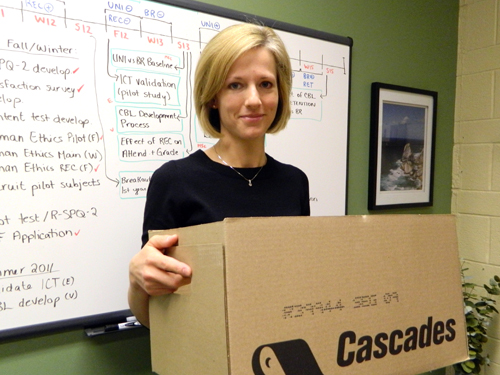At Guelph presents this story as part of a series that highlights University of Guelph leadership in teaching excellence and the scholarship of learning.

“I was a very good student but a terrible learner,” says human health and nutritional sciences (HHNS) professor Genevieve Newton.
Despite being an “A” student, she didn’t realize there was a gap in her learning experience until, after graduating from Laurentian University with a B.Sc., she headed to Chicago to study chiropractic medicine at the National University of Health Science (NUHS). There she discovered a whole new approach to teaching that changed the way she thought about learning.
“The problem-based learning curriculum my profs used taught me how to really learn and understand the material,” she says.
During her time at the NUHS, she also became interested in nutrition. She describes it as the umbrella over all the other health sciences. “Nutrition explains so much,” she says. “Without information about nutrition, what we can do to prevent and treat disease is limited.” Her initial goal was to attend U of G to get a master’s in nutrition, giving her the option to share nutrition information with her chiropractic patients.
But once she started graduate school at U of G, “I couldn’t leave,” Newton says. “I had lots of opportunities to teach in grad school and I realized that I have a passion for teaching. I wanted to give my students the same kind of powerful learning experiences I’d had.” Her PhD focused on the role of niacin in cognitive functioning – a traditional nutrition topic – but she was already finding her greatest interest was in improving approaches to teaching.
“My experience with the problem-based learning was so profound that it changed my whole career direction,” says Newton. “I want my students to have the same kind of transformational learning experiences.”
The approaches she is studying (and using) require quite a bit of work on the part of the professor, who needs to be prepared for any number of questions and requests from the students.
“The problem-based approach often uses case studies to guide learning,” she explains. In this model, students may work as a group, and are initially presented with a basic outline of the case they are to work on. The teacher or facilitator has a binder full of information about the case, but doesn’t provide any until it’s requested. The students need to do research and plan their approach to know what to ask for.
Newton recalls one example from chiropractic school: “The case would start out with a person coming into the chiropractor’s office with low back pain. We’d start with what questions would we ask, what tests would we do, what kind of X-rays would we request.” Each student in the group would end up researching some aspects of the problem, then reporting back to the group to discuss the information and continue planning.
“This approach is also used at McMaster’s medical school,” she says.
It’s relatively easy to see how this can work for teaching medical practitioners, but Newton says it can be applied to many other disciplines as well. In a biochemistry class, for example, she might have students explore what happens in the bodies of people on various diets, such as the Atkins diet, the Zone diet and the American Heart Association diet, and how this affects weight loss. “There are also other active learning techniques designed to get students to engage with the material, problem-solve and think critically,” she says.
After graduation, Newton taught as a sessional lecturer in the Guelph-Humber kinesiology program. Following a maternity leave, she took the opportunity to diversify her teaching experience by teaching both undergraduate and graduate courses in HHNS at U of G. That’s when her teaching research began. “I wanted to know if what I was doing in class was working,” she says. “So I turned it into a formal research project.”
Now, as a faculty member in HHNS, her current teaching assignments will bring her back to the Guelph-Humber kinesiology program, in addition to her teaching at U of G. Over the next three years, Newton will be using case studies in second-year biochemistry courses and studying the outcomes. “We want to know if this will affect the retention of the material, and whether or not it encourages deep learning rather than surface learning.” She’s also looking at whether or not breakout groups can be used successfully in large undergraduate classes, and whether lecture videos are useful study tools.
Her approaches always aim to provide students with more than facts to be memorized. They also give them transferable skills in critical thinking, research and ways to learn. “Learning is all about integrating new knowledge with what you already know and making the connections,” she explains. “People are recognizing the limitations of the traditional ways of teaching and looking at innovative ways to facilitate learning.”